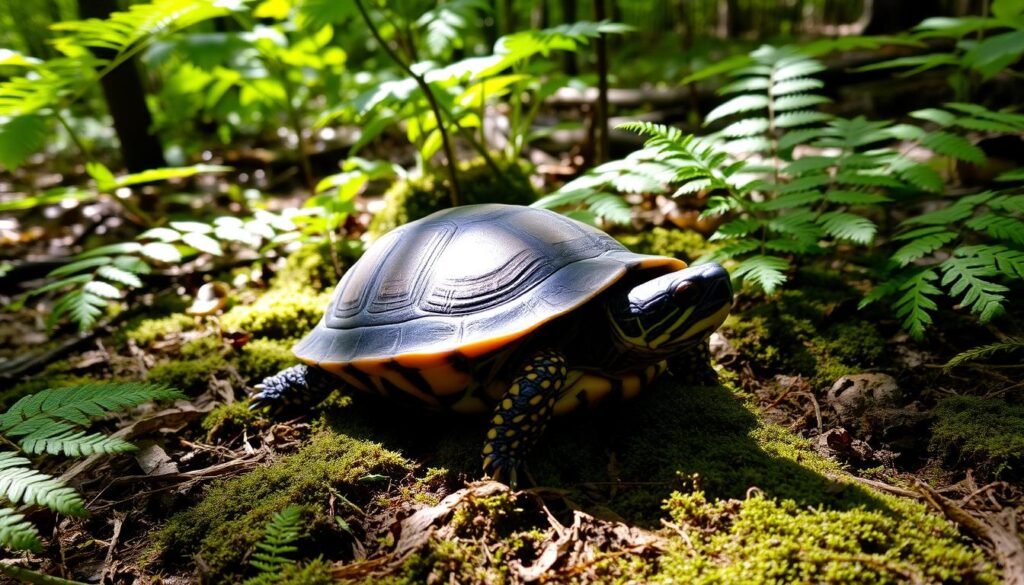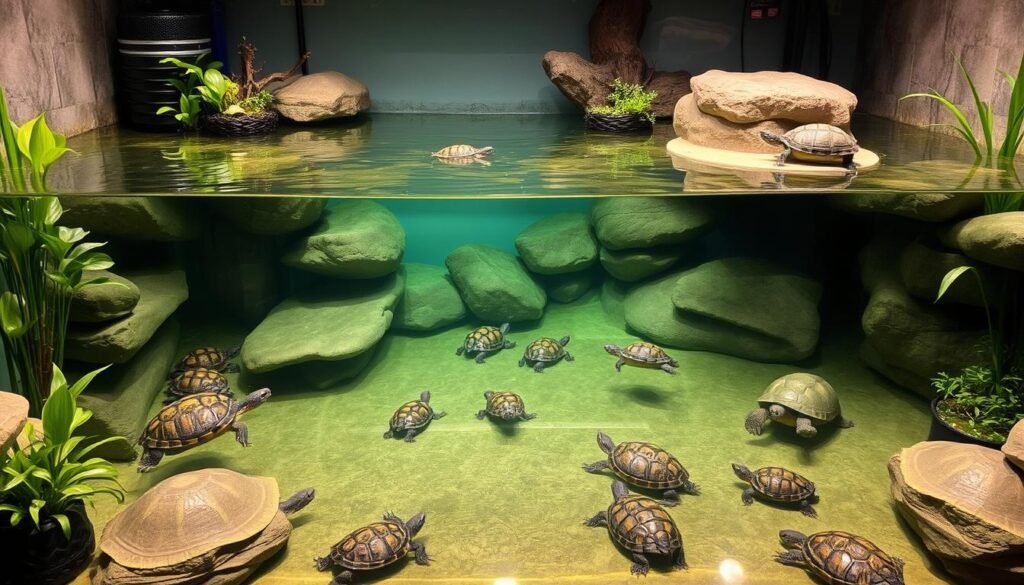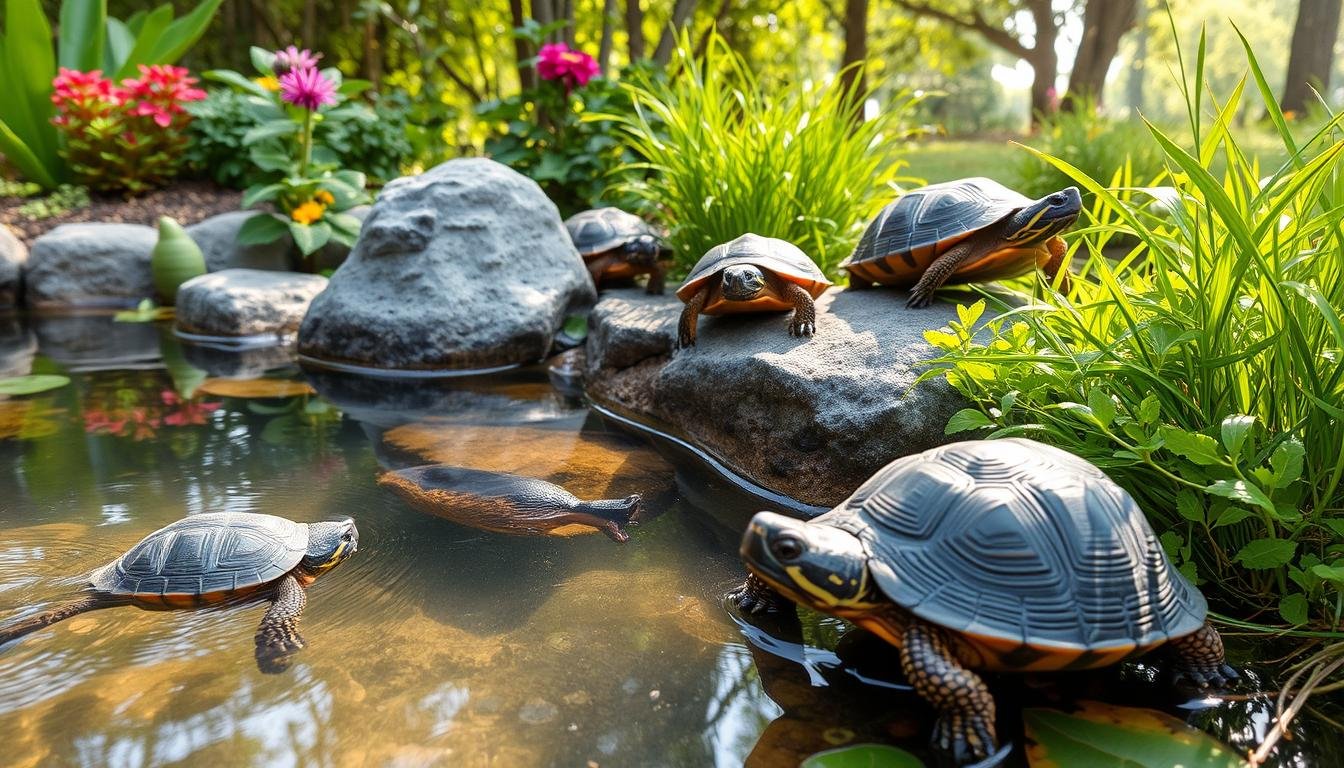Finding the best pet turtle is an enriching adventure. Turtles bring a special kind of joy to homes. They are becoming more popular as family pets. But, future turtle owners must understand the big commitment. Turtles need special care and can live for decades. This long life means owners must be ready for a long-term commitment.
The CDC advises checking if your home is right for a pet turtle. This is especially true for homes with young kids, older adults, or anyone with a weaker immune system. Turtles can bring health risks, like Salmonella. Taking care of a pet turtle involves more than just enjoying their company. They need a safe home, clean water, and regular vet visits. This care helps them stay healthy and happy.
The Red-Eared Slider is a popular choice for its friendly nature and colorful look. Yet, it needs a big tank and a strong filter for a clean living space. Whether you pick a Spotted Turtle or a Reeve’s Turtle, the care they need is important. Your lifestyle and willingness to provide this care are key. Thus, picking the best pet turtle depends on your readiness to bond with these amazing animals.
Understanding Turtles as Pets and Their Care Requirements
Getting a turtle means learning a lot about them. This includes both the turtle species and their captive care needs. Turtles can live a very long time, some even becoming family heirlooms if taken care of properly. It’s also important to keep things clean because turtles can carry Salmonella.
If you’re new to turtles, you might not realize how much care they need. You have to make their space like their natural habitat. It’s also good to know if your turtle is a boy or a girl, especially if you think about breeding. Boys and girls can be told apart by things like tail length and eye color.
- Ensure the tank is spacious enough – a good rule is to provide a tank that is at least five times the length of the turtle, with a depth of water approximately 2.5 times the length of the turtle.
- A temperature-regulated basking area is vital, with temperatures advised to be between 85 to 95 degrees Fahrenheit.
- Regular water quality tests are indispensable to prevent diseases and ensure a healthy environment for your aquatic pet.
- Daily feeding routines are encouraged for baby turtles, while adults thrive with meals every 2-3 days to avoid excess weight gain.
- Powdered or liquid vitamin supplements can be crucial, especially for preventing common issues like Vitamin A deficiency which leads to eye health problems.
Diet and how you interact with them are big parts of a turtle’s life. Many owners say their turtles can recognize them and react, which shows they form bonds. Deciding if turtles should live alone or with others is important too. Letting pet turtles go into the wild can hurt local ecosystems and spread diseases.
| Aspect | Requirement | Details |
|---|---|---|
| Enclosure Size | 10 gallons per inch of shell | This ensures enough room for swimming and basking for smaller turtle species. |
| Life Expectancy | 20 to 60+ years | Dependent on species and quality of care. Tortoises can live over 100 years. |
| Health Monitoring | Regular vet check-ups | Important for early detection of health issues, especially shell and respiratory diseases. |
Thinking about a turtle as a pet? It’s key to know their care needs. This is vital for beginners who want their new reptile friend to thrive.
Creating an Ideal Habitat for Your Turtle
To make sure aquatic turtles are healthy, we must create a perfect home. This space should be big, clean, and have everything they need. These needs include a large tank with pure water, an efficient filter, and a warm spot for basking under UV light. Let’s look at what’s important:
Aquarium Size and Setup
Turtles need space to move and stay fit. They require an enclosure with at least 10 gallons of water per inch of their shell. For smaller species, start with a 40-gallon tank. As the turtle gets bigger, the tank should too, to keep them happy and healthy. Now, let’s discuss water quality:
| Parameter | Optimal Value |
|---|---|
| Water Temperature | 75°F |
| pH Level | 6.0 – 8.0 |
| Ammonia | 0 |
| Nitrite | 0.5 ppm or less |
| Nitrate | 40 ppm or less |
The Importance of a Filtration System
Turtles are messy, making a strong filtration system key for clean water. This system should tackle waste with both mechanical and biological filters. It’s crucial to test the water often. This way, you can keep the water safe for your turtle by adjusting levels as needed.
Basking Area and UV Light Essentials
Turtles need a special place to dry off and get sunlight. This spot should let them fully leave the water and be warm. The temperature should be between 85°F and 95°F. Also, UV light is a must for their health. It helps them make vitamin D for strong bones. Put the UV light close but change it every 6 months for best results.
By taking care of these habitat aspects, you’ll give your turtle a wonderful life in its home.
Turtles That Are Good Pets

Picking a turtle as a pet means knowing what they need and how they act. We’ll look at three popular types of pet turtles. Each has its own home needs and fits well with beginners or those who’ve kept turtles before.
Red-Eared Slider: A Popular Choice
The red-eared slider is a top pick, especially for new turtle owners. They come from the southeastern United States. With a red mark near their ears, these water turtles need a big tank and a good water filter. This keeps their living space clean and healthy. They’re friendly, living 20-40 years, so they’re a long-term friend.
Musk Turtle: Small and Low-maintenance
The common musk turtle, or stinkpot, is small and perfect if you don’t have much room. Though they’re shy and prefer less touching, they do well in an aquarium. They need less space, but clean water is a must. Their size and easy upkeep make them great for beginners or those a bit more experienced.
Eastern Box Turtle: Ideal for Land-Based Habitats
The eastern box turtle does best in a land home, with a little water dish nearby. To keep them happy, their space must stay at the right dampness and warmth. Sometimes, this means they live both inside and outside. They eat both plants and animals. These turtles might live up to 100 years, needing lots of care.
| Turtle Species | Adult Size | Life Expectancy | Preferred Habitat |
|---|---|---|---|
| Red-Eared Slider | 12 inches | 20-40 years | Aquatic |
| Common Musk Turtle | 3-5 inches | 50+ years | Aquatic |
| Eastern Box Turtle | 5-6 inches | 25-100 years | Terrestrial |
Choosing a red-eared slider, a common musk turtle, or an eastern box turtle requires knowing their needs. This means everything from their home to what they eat. These turtles come from different places—water to land. This gives you options for your home and what you can handle.
Dietary Needs of Pet Turtles
It’s important to know what pet turtles need to eat to stay healthy and live long. Different ages of turtles need different foods. Young turtles need more protein to grow, while adults need more greens.
Feeding Schedule for Young and Adult Turtles
Feeding turtles like they eat in the wild is key for their health. Young turtles need to eat every day to support their growth. Adult turtles should eat every two or three days to stay healthy and avoid getting overweight.
Combination of Insects, Fish, and Leafy Greens
Turtles eat a mix of protein, greens, and pelleted food. Small fish and insects help build their muscles and shell. Greens like kale and collard greens give them needed vitamins and minerals.
A balanced turtle diet has animal protein and lots of greens. This is like their natural diet in the wild. Young turtles eat more protein, while adults eat more plants.
Supplements like calcium and vitamins are also key to a turtle’s diet. They prevent health problems in young and adult turtles. A balanced diet and proper schedule help keep your turtle healthy and happy.
Companions for Your Turtle: Ensuring Compatibility
Choosing a friend for your turtle is big deal. You want to make your turtle’s home feel lively and more natural. But, it’s not just about getting any fish or creature. You need to pick ones that get along well with your turtle.
But be careful, because not all creatures make good buddies for your turtle. Turtles might chase smaller or slower fish. So, you must choose tank mates carefully to keep everyone safe.
- Snails: They’re great at cleaning up leftovers and algae in the tank.
- Ghost Shrimp: While there’s some risk, they’re good at staying away from turtles and can be quite fun to watch.
| Tank Mate | Size Compatibility | Recommended Tank Size |
|---|---|---|
| Bala Shark | Up to 13 inches | 150 gallons |
| Oscar | 12 to 18 inches | 150 gallons |
| Silver Dollar | Up to 6 inches | 150 gallons |
| Chinese Algae Eater | 6 to 10 inches | 150 gallons |
| Kissing Gourami | Up to 12 inches | 150 gallons |
Choosing the right friends for your turtle means thinking about their size and your tank’s size. A bigger tank means more room for everyone and less stress. Just remember, turtles may think of these new friends as food. So, watch them closely at first to make sure they all get along.
Maintaining a Healthy Environment: Cleaning and Maintenance

Turtles like environments that mirror their natural settings, combining water and land. Keeping the water clean is key for their health. Doing this well helps them stay healthy and avoid sickness.
Regular Water Testing and Changes
Checking the water’s pH, ammonia, and nitrite levels is vital. You should test the water every week. This keeps the water safe for turtles. If the water quality drops, it might mean there’s bacteria or toxins. To stay on track, monitor these:
- Ammonia: Should always be near zero as it is highly toxic.
- Nitrite: Also should be kept as low as possible to prevent poisoning.
- pH Levels: Ideally should range between 6.5 and 8.0, depending on the species.
Plan on changing 25% to 50% of the water each week. This helps remove waste and harmful substances. It greatly improves the water’s quality.
Creating a Safe and Clean Space
A clean, safe habitat is just as important as water quality. Make sure the basking area is clean and uncontaminated. This helps the turtle’s shell stay healthy. Clean land areas in the tank and disinfect habitat pieces once a month. Here’s what you should do every month:
- Clean the basking area to keep it dry and free from algae or slime.
- Disinfect the decor to prevent bacterial infections.
- Change the filter media as recommended by the manufacturer to ensure efficiency.
Following these steps can prevent diseases and help your turtle thrive.
| Care Aspect | Description | Frequency |
|---|---|---|
| Water Quality Testing | Test for ammonia, nitrite, nitrates, and pH levels. | Weekly |
| Water Change | Replace 25%-50% of tank water. | Weekly |
| Tank Cleaning | Remove waste and food debris, clean glass, and rinse substrate. | Monthly |
| Filter Maintenance | Clean or replace filter media. | Monthly |
| Deep Cleaning | Thorough cleaning requiring removal and cleaning of all tank components and substrate. | Bi-annually |
Common Health Concerns and Preventive Care for Pet Turtles
Keeping your pet turtle healthy means watching for issues like shell rot and respiratory infections. You also need to look out for trouble with shedding scutes. Doing these things is key to keeping your turtle in good shape. It also helps stop the spread of diseases like salmonella from your reptile.
Observing for Signs of Illness
It’s important to notice if your turtle acts sick. Signs of illness can be unusual shedding, trouble breathing, or changes in the shell. Turtles can get very sick from not getting enough vitamin A. This could make them produce a lot of mucus, breathe with their mouths open, and become very tired.
Preventing Salmonella Transmission
Handling reptiles can sometimes lead to salmonella, a big worry with turtles. Because of this, there’s a law from 1975 in the US. It stops people from selling small turtles to reduce salmonella infections, especially in kids. Always wash your hands after touching your turtle or anything in its home. Keeping your turtle’s home clean also lowers the risk of salmonella and other problems.
The Importance of Regular Veterinary Check-ups
Seeing a vet who knows about reptiles is very important for your turtle’s health. Get a check-up for your new turtle within the first few days you have it. Then, take it for a check-up every year. These visits help catch and treat issues early on. Some problems they might find include bone disease or worms, which could really harm your turtle’s health and happiness.
| Health Issue | Symptoms | Treatment |
|---|---|---|
| Respiratory Infections | Wheezing, nasal discharge, difficulty breathing | Antibiotics and vitamin A supplementation |
| Shell Rot | Pitting, discoloration, soft spots on the shell | Antifungal or antibacterial treatment |
| Metabolic Bone Disease | Misshapen shell, deformed bones | Calcium and vitamin D supplementation |
| Vitamin A Deficiency | Swollen eyelids, lack of appetite, lethargy | Dietary correction, injectable vitamin A |
| Internal Parasites | Diarrhea, weight loss | Deworming medications following stool analysis |
Choosing the Right Turtle Species for Your Lifestyle
Picking the right turtle for you means thinking about your lifestyle and what you can handle. Some people love water turtles, like the yellow-bellied slider, and others prefer turtles that live in ponds outside. Each kind of turtle needs different things.
If you’re new to turtle pets, start with an easy one. This means turtles that don’t need complex homes or special food. It’s also good to know how big they get and how long they live. Like the western painted turtle or the yellow-bellied slider, some need your care for a long time.
- Aquatic Turtles: These turtles need lots of water and a place to dry off. They love to swim. Clean water is a must for them.
- Pond Turtles: These are great for your garden pond. They like to swim and sunbathe. Make sure they can’t get out of the pond.
- Land Turtles: They don’t need much water. But they do need a big space with heat and light.
Here’s a table that shows the differences between some popular turtles:
| Species | Average Lifespan | Typical Size (inches) | Environment |
|---|---|---|---|
| Western Painted Turtle | 50 years | Up to 10 | Aquatic |
| Yellow-bellied Slider | 20-30 years | Up to 12 | Aquatic |
| Common Musk Turtle | 50 years | 3-5.5 | Aquatic/Semi-aquatic |
| Spotted Turtle | Up to 100 years | 4-6 | Semi-aquatic |
Each turtle species has its own needs. For example, the western painted turtle loves a lively water home. The yellow-bellied slider, great for beginners, needs its water changed a lot to stay clean. Thinking about these things helps you make a good home for your turtle.
Conclusion
Turtles are not just pets, they are friends for life. They bring a special joy and calm to our homes. With over 350 types worldwide, they give us many options to choose from. Picking the right turtle is more than what we want; it’s a promise to take care of them for years.
Having a turtle means creating a peaceful space at home. It’s also about learning how to feed and care for them properly. For example, they need the right lighting and a diet that fits them. Caring for turtles teaches us to pay attention to their habitat and health needs. If we’re ready to give time and love, turtles can make our lives less stressful.
But remember, turtles need our steady care to stay happy and healthy. This dedication pays off by making our home a better place for them and us. Choosing a turtle as a pet means building a lasting bond. Each turtle, from the colorful Painted Turtle to the grand tortoises, offers a chance to bring joy into our lives. It’s about finding the right turtle that matches our home and heart.
FAQ
What are some turtles that are good pets for beginners?
Beginners often choose the Red-Eared Slider or the Musk Turtle. They are hardier and easier to care for than other types.
What are the general care requirements for a pet turtle?
Your pet turtle will need a right-sized home and a filtration system. It also requires a basking area with UV light and a balanced diet. Regular check-ups and a clean home are essential for their well-being.
How big should an aquarium be for an aquatic turtle?
Start with a 40-gallon tank for small to medium turtles. Bigger turtles or adults need more space for growth and to move around.
Why is a filtration system important for turtle enclosures?
Turtles make a lot of mess, especially when they eat. A good filter keeps the water clean. This is crucial for the turtle’s health.
What should be included in a turtle’s diet?
Being omnivores, turtles need proteins like insects and fish and veggies, especially leafy greens. This combination ensures they get a balanced diet.
Can other animals be kept in the same tank as my turtle?
Some small fish, crustaceans, and snails can live with turtles. Choose companions carefully, though. Turtles might eat them. Include hiding spots to keep everyone safe.
What is involved in maintaining a clean and healthy environment for my turtle?
Keep their home clean by changing the water regularly. Check the water’s pH and ammonia, and keep their basking spot clean.
What are some common health concerns for pet turtles?
Watch out for respiratory infections, shell rot, and odd shell shedding. Notice any illness signs and see a vet if needed.
How do I prevent transmitting Salmonella from my turtle to my family?
Wash your hands well with soap and water after touching your turtle or its home. Avoid letting turtles near where you make or eat food.
How do I choose the right turtle species for my lifestyle?
Think about the turtle’s size when grown-up, whether it needs land or water, and how active it is. Also, consider its lifespan and your ability to care for it long-term. This helps in choosing the right pet turtle for you.













